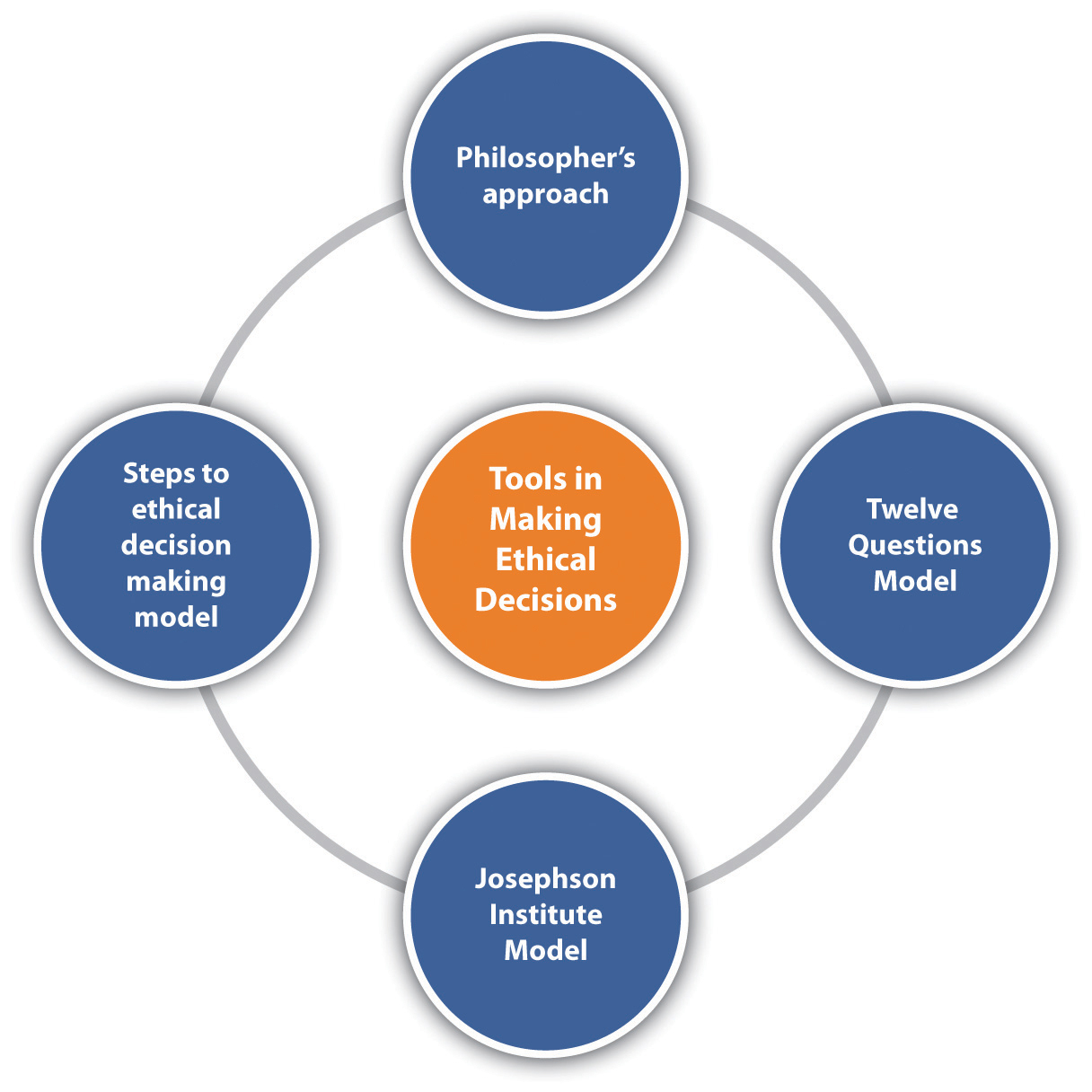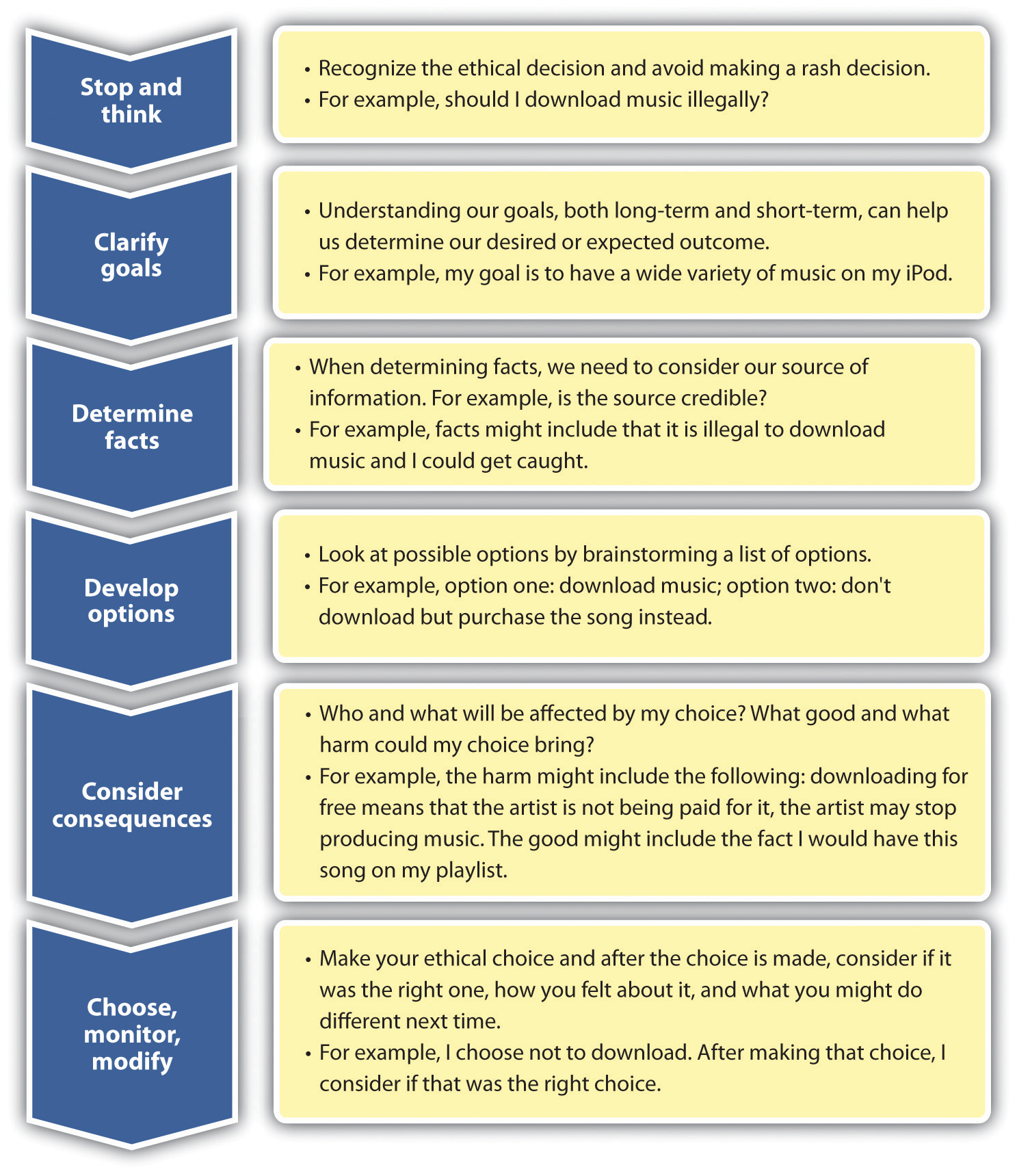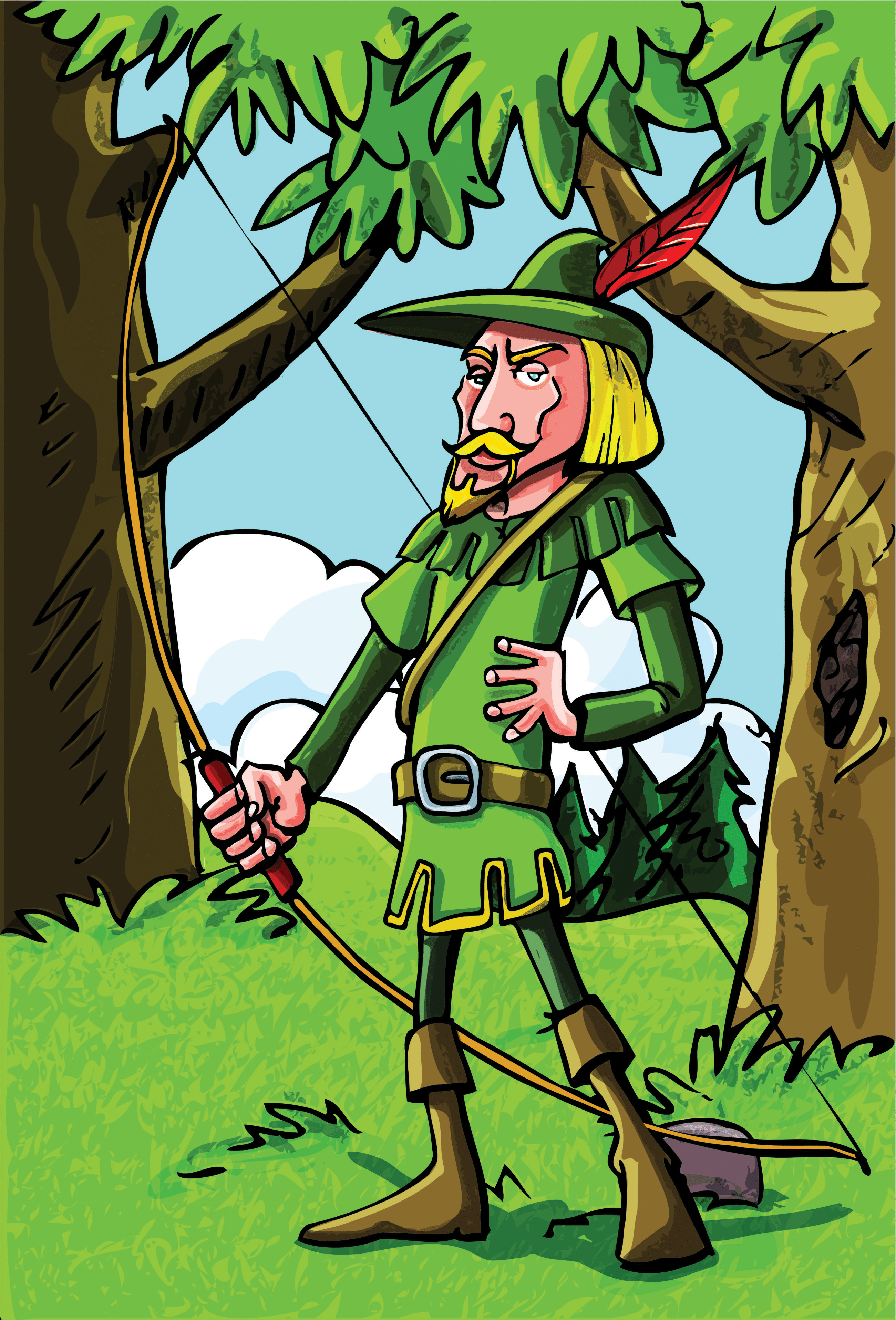This is “Making Ethical Decisions”, section 5.2 from the book Beginning Human Relations (v. 1.0). For details on it (including licensing), click here.
For more information on the source of this book, or why it is available for free, please see the project's home page. You can browse or download additional books there. To download a .zip file containing this book to use offline, simply click here.
5.2 Making Ethical Decisions
Learning Objective
- Be able to explain the models you can use for ethical decision making.
Now that we have working knowledge of ethics, it is important to discuss some of the models we can use to make ethical decisions. Understanding these models can assist us in developing our self-management skills and relationship management skills. These models will give you the tools to make good decisions, which will likely result in better human relations within your organization.
Note there are literally hundreds of models, but most are similar to the ones we will discuss. Most people use a combination of several models, which might be the best way to be thorough with ethical decision making. In addition, often we find ethical decisions to be quick. For example, if I am given too much change at the grocery store, I may have only a few seconds to correct the situation. In this case, our values and morals come into play to help us make this decision, since the decision making needs to happen fast.
Do Today’s Youth Have a Code of Ethics?
(click to see video)Howard Gardner with University of Massachusetts Law School discusses ethics and youth.
The Twelve Questions Model
Laura Nash, an ethics researcher, created the Twelve Questions Model as a simple approach to ethical decision making.Nash, L. (1981). Ethics without the sermon. Howard Business Review, 59 79–90, accessed February 24, 2012, http://www.cs.bgsu.edu/maner/heuristics/1981Nash.htm In her model, she suggests asking yourself questions to determine if you are making the right ethical decision. This model asks people to reframe their perspective on ethical decision making, which can be helpful in looking at ethical choices from all angles. Her model consists of the following questions:Nash, L. (1981). Ethics without the sermon. Howard Business Review, 59 79–90, accessed February 24, 2012, http://www.cs.bgsu.edu/maner/heuristics/1981Nash.htm
- Have you defined the problem accurately?
- How would you define the problem if you stood on the other side of the fence?
- How did this situation occur in the first place?
- To whom and what do you give your loyalties as a person and as a member of the company?
- What is your intention in making this decision?
- How does this intention compare with the likely results?
- Whom could your decision or action injure?
- Can you engage the affected parties in a discussion of the problem before you make your decision?
- Are you confident that your position will be as valid over a long period of time as it seems now?
- Could you disclose without qualms your decision or action to your boss, your family, or society as a whole?
- What is the symbolic potential of your action if understood? If misunderstood?
- Under what conditions would you allow exceptions to your stand?
Consider the situation of Catha and her decision to take home a printer cartilage from work, despite the company policy against taking any office supplies home. She might go through the following process, using the Twelve Questions Model:
- My problem is that I cannot afford to buy printer ink, and I have the same printer at home. Since I do some work at home, it seems fair that I can take home the printer ink.
- If I am allowed to take this ink home, others may feel the same, and that means the company is spending a lot of money on printer ink for people’s home use.
- It has occurred due to the fact I have so much work that I need to take some of it home, and often I need to print at home.
- I am loyal to the company.
- My intention is to use the ink for work purposes only.
- If I take home this ink, my intention may show I am disloyal to the company and do not respect company policies.
- The decision could injure my company and myself, in that if I get caught, I may get in trouble. This could result in loss of respect for me at work.
- Yes, I could engage my boss and ask her to make an exception to the company policy, since I am doing so much work at home.
- No, I am not confident of this. For example, if I am promoted at work, I may have to enforce this rule at some point. It would be difficult to enforce if I personally have broken the rule before.
- I would not feel comfortable doing it and letting my company and boss know after the fact.
- The symbolic action could be questionable loyalty to the company and respect of company policies.
- An exception might be ok if I ask permission first. If I am not given permission, I can work with my supervisor to find a way to get my work done without having a printer cartridge at home.
As you can see from the process, Catha came to her own conclusion by answering the questions involved in this model. The purpose of the model is to think through the situation from all sides to make sure the right decision is being made.
As you can see in this model, first an analysis of the problem itself is important. Determining your true intention when making this decision is an important factor in making ethical decisions. In other words, what do you hope to accomplish and who can it hurt or harm? The ability to talk with affected parties upfront is telling. If you were unwilling to talk with the affected parties, there is a chance (because you want it kept secret) that it could be the wrong ethical decision. Also, looking at your actions from other people’s perspectives is a core of this model.
Figure 5.3

Some of the possible approaches to ethical decision making. No one model is perfect, so understanding all of the possibilities and combining them is the best way to look at ethical decision making.
Josephson Institute of Ethics’ Model
Josephson Institute of Ethics uses a model that focuses on six steps to ethical decision making. The steps consist of stop and think, clarify goals, determine facts, develop options, consider consequences, choose, and monitor/modify.
As mentioned, the first step is to stop and think. When we stop to think, this avoids rash decisions and allows us to focus on the right decision-making process. It also allows us to determine if the situation we are facing is legal or ethical. When we clarify our goals, we allow ourselves to focus on expected and desired outcomes. Next, we need to determine the facts in the situation. Where are we getting our facts? Is the person who is providing the facts to us credible? Is there bias in the facts or assumptions that may not be correct? Next, create a list of options. This can be a brainstormed list with all possible solutions. In the next step, we can look at the possible consequences of our actions. For example, who will be helped and who might be hurt? Since all ethical decisions we make may not always be perfect, considering how you feel and the outcome of your decisions will help you to make better ethical decisions in the future. Figure 5.4 "An Example of Josephson’s Model when Dealing with the Ethical Situation of Downloading Music from Share Websites." gives an example of the ethical decision-making process using Josephson’s model.
Figure 5.4 An Example of Josephson’s Model when Dealing with the Ethical Situation of Downloading Music from Share Websites.

Steps to Ethical Decision Making
There are many models that provide several steps to the decision-making process. One such model was created in the late 1990s for the counseling profession but can apply to nearly every profession from health care to business.Corey, G., Corey, M . S., & Callanan, P. (1998). Issues and ethics in the helping professions. Toronto: Brooks/Cole Publishing Company; Syracuse School of Education. (n.d.). An ethical decision making model, accessed February 24, 2012, http://soe.syr.edu/academic/counseling_and_human_services/modules/Common_Ethical_Issues/ethical_decision_making_model.aspx In this model, the authors propose eight steps to the decision-making process. As you will note, the process is similar to Josephson’s model, with a few variations:
- Step 1: Identify the problem. Sometimes just realizing a particular situation is ethical can be the important first step. Occasionally in our organizations, we may feel that it’s just the “way of doing business” and not think to question the ethical nature.
- Step 2: Identify the potential issues involved. Who could get hurt? What are the issues that could negatively impact people and/or the company? What is the worst-case scenario if we choose to do nothing?
- Step 3: Review relevant ethical guidelines. Does the organization have policies and procedures in place to handle this situation? For example, if a client gives you a gift, there may be a rule in place as to whether you can accept gifts and if so, the value limit of the gift you can accept.
- Step 4: Know relevant laws and regulations. If the company doesn’t necessarily have a rule against it, could it be looked at as illegal?
- Step 5: Obtain consultation. Seek support from supervisors, coworkers, friends, and family, and especially seek advice from people who you feel are moral and ethical.
- Step 6: Consider possible and probable courses of action. What are all of the possible solutions for solving the problem? Brainstorm a list of solutions—all solutions are options during this phase.
- Step 7: List the consequences of the probable courses of action. What are both the positive and negative benefits of each proposed solution? Who can the decision affect?
- Step 8: Decide on what appears to be the best course of action. With the facts we have and the analysis done, choosing the best course of action is the final step. There may not always be a “perfect” solution, but the best solution is the one that seems to create the most good and the least harm.
Most organizations provide such a framework for decision making. By providing this type of framework, an employee can logically determine the best course of action. The Department of Defense uses a similar framework when making decisions, as shown in Note 5.14 "Department of Defense Decision-Making Framework".
Department of Defense Decision-Making Framework
The Department of Defense uses a specific framework to make ethical decisions.United States Department of Defense. (1999). Joint Ethics Regulation DoD 5500.7-R., accessed February 24, 2012, http://csweb.cs.bgsu.edu/maner/heuristics/1999USDepartmentOfDefense.htm and http://ogc.hqda.pentagon.mil/EandF/Documentation/ethics_material.aspx
-
Define the problem.
- State the problem in general terms.
- State the decisions to be made.
-
Identify the goals.
- State short-term goals.
- State long-term goals.
- List appropriate laws or regulations.
- List the ethical values at stake.
-
Name all the stakeholders.
- Identify persons who are likely to be affected by a decision.
- List what is at stake for each stakeholder.
-
Gather additional information.
- Take time to gather all necessary information.
- Ask questions.
- Demand proof when appropriate.
- Check your assumptions.
-
State all feasible solutions.
- List solutions that have already surfaced.
- Produce additional solutions by brainstorming with associates.
- Note how stakeholders can be affected (loss or gain) by each solution.
-
Eliminate unethical options.
- Eliminate solutions that are clearly unethical.
- Eliminate solutions with short-term advantages but long-term problems.
- Rank the remaining options according to how close they bring you to your goal, and solve the problem.
- Commit to and implement the best ethical solution.
Philosopher’s Approach
Philosophers and ethicists believe in a few ethical standards, which can guide ethical decision making. First, the utilitarian approachA source of ethical standards that says, when choosing one ethical action over another, we should select the one that does the most good and least harm. says that when choosing one ethical action over another, we should select the one that does the most good and least harm. For example, if the cashier at the grocery store gives me too much change, I may ask myself, if I keep the change, what harm is caused? If I keep it, is any good created? Perhaps the good created is that I am not able to pay back my friend whom I owe money to, but the harm would be that the cashier could lose his job. In other words, the utilitarian approach recognizes that some good and some harm can come out of every situation and looks at balancing the two.
In the rights approachA source of ethical standards that says we look at how our actions will affect the rights of those around us., we look at how our actions will affect the rights of those around us. So rather than looking at good versus harm as in the utilitarian approach, we are looking at individuals and their rights to make our decision. For example, if I am given too much change at the grocery store, I might consider the rights of the corporation, the rights of the cashier to be paid for something I purchased, and the right of me personally to keep the change because it was their mistake.
The common good approachA source of ethical standards that says, when making ethical decisions, we should try to benefit the community as a whole. says that when making ethical decisions, we should try to benefit the community as a whole. For example, if we accepted the extra change in our last example but donated to a local park cleanup, this might be considered OK because we are focused on the good of the community, as opposed to the rights of just one or two people.
The virtue approachA source of ethical standards that looks at desirable qualities and says we should act to obtain our highest potential. asks the question, “What kind of person will I be if I choose this action?” In other words, the virtue approach to ethics looks at desirable qualities and says we should act to obtain our highest potential. In our grocery store example, if given too much change, someone might think, “If I take this extra change, this might make me a dishonest person—which I don’t want to be.”

The common good approach to ethics is similar to Robin Hood’s approach. Steal from the rich to give to the poor, because that was better for the common good. What do you think are the challenges or downsides to this approach?
© Thinkstock
The imperfections in these approaches are threefold:Santa Clara University. (n.d.). A framework for thinking ethically, accessed February 24, 2012, http://www.scu.edu/ethics/practicing/decision/framework.html
- Not everyone will necessarily agree on what is harm versus good.
- Not everyone agrees on the same set of human rights.
- We may not agree on what a common good means.
Because of these imperfections, it is recommended to combine several approaches discussed in this section when making ethical decisions. If we consider all approaches and ways to make ethical decisions, it is more likely we will make better ethical decisions. By making better ethical decisions, we improve our ability to self-manage, which at work can improve our relationships with others.
Key Takeaways
- We can use a variety of models and frameworks to help us in ethical decision making. For example, one such model is the Twelve Questions Model. This model encourages us to ask questions such as who this decision affects to determine the best ethical choice.
- Josephson’s model consists of six steps. They include stop and think, clarify goals, determine facts, develop options, consider consequences, choose, and monitor/modify.
- Another model discussed has the following steps: identify the problem, identify the potential issues involved, review relevant ethical guidelines, know relevant laws and regulations, obtain consultation, consider possible and probable courses of action, list the consequences of the probable courses of action, and decide on what appears to be the best course of action.
- Philosophers look at ethical frameworks following a utilitarian approach, common good approach, rights approach, and the virtue approach. These approaches provide a framework for sound ethical decision making.
Exercises
- Think of a recent ethical decision you have made. Using the model or framework of your choice, discuss how you went through the process of making a sound ethical decision.
- What are the strengths and weaknesses of each model presented in this section? How can you combine them all to make ethical decisions?




